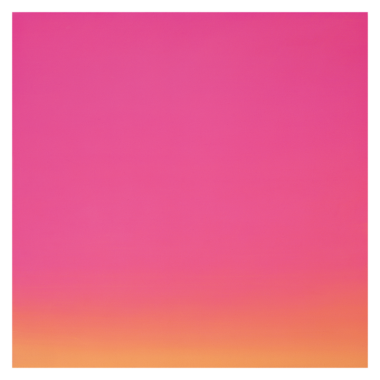
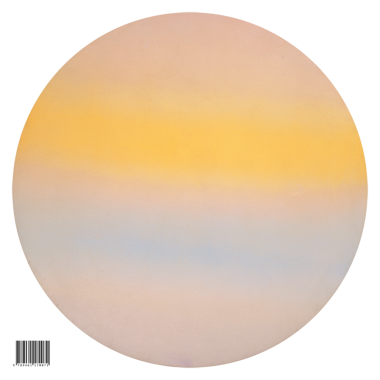
Jef Verheyen, Le Peintre Flamant
Softcover, 256 pp., offset 4/1, 230 x 230 mm
English and German
Edition of 2000
ISBN 978-94-611-7007-1
Published by ASA Publishers
$60.00 ·
Jef Verheyen (1932-1984) is one of the most important Flemish artists of the twentieth century. This book brings together contributions from international authors, exploring for the first time, from a variety of perspectives, Verheyen’s art and his close connections with the avant-garde Group ZERO. A quarter of a century after his untimely death, Verheyen’s abstract paintings are re-examined, interpreted and accorded their place in the history of art. The production of the book has led to the rediscovery of a painter who had fallen into oblivion. Here, unpublished texts and letters and a wealth of photographs bring Verheyen’s creations back to life. Book published on the occasion of ‘Jef Verheyen & Friends,’ at the Langen Foundation in Neuss.
“Jef Verheyen painted an essential distillation of his vision, a perfume of the visible, and his paintings offer their viewers possibilities of seeing something new, remembering things forgotten, and experiencing things they have never experienced before.”
— Dirk Pörschmann
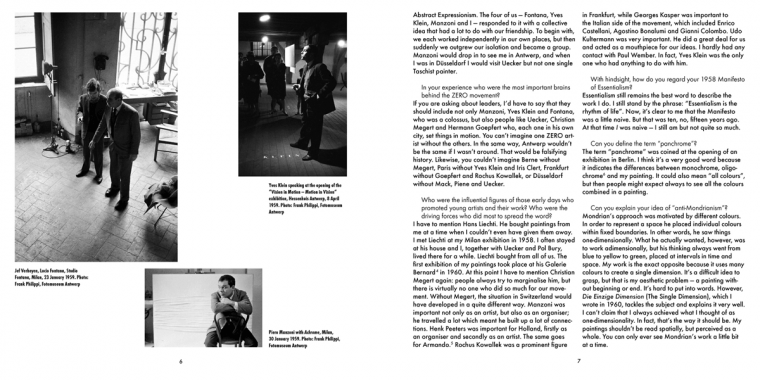
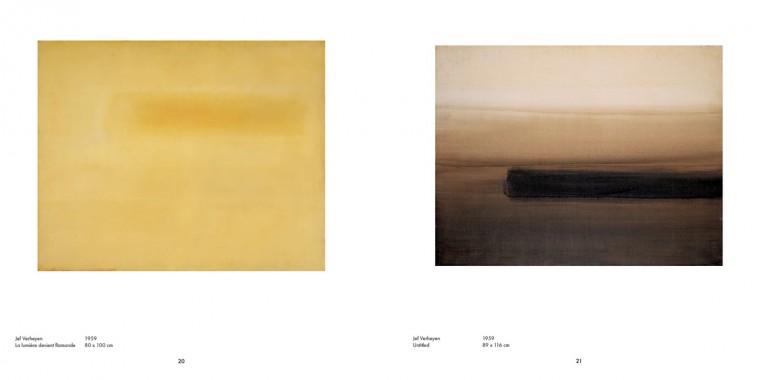
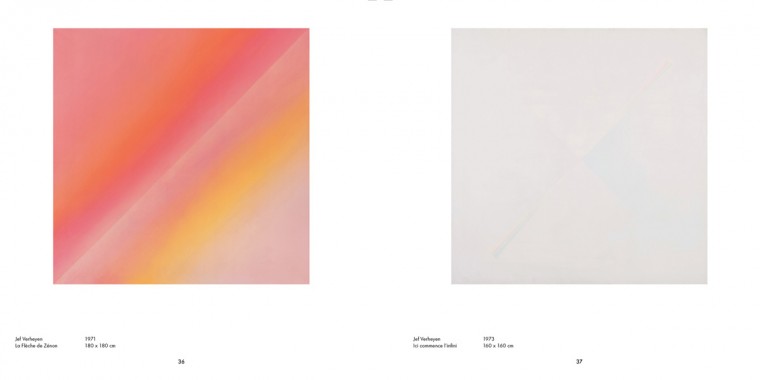
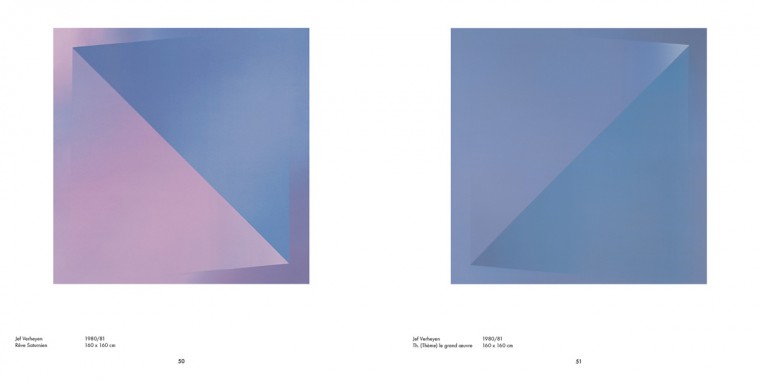
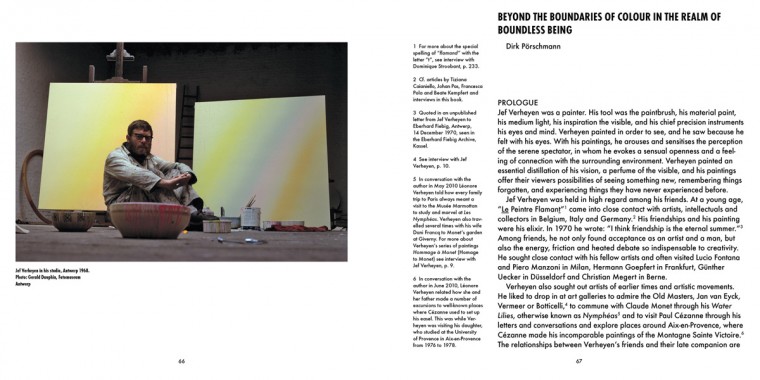
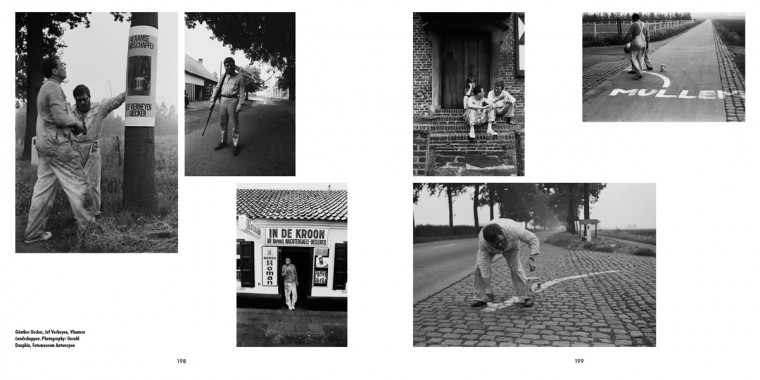
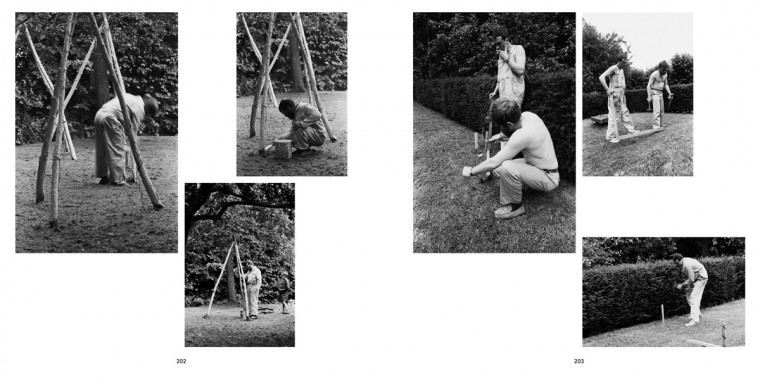
Art, ASA Publishers, Beate Kemfert, Dirk Pörschmann, Distribution, Francesca Pola, Jef Verheyen, Jenny Trautwein, Johan Pas, Langen Foundation, Léonore Verheyen, MER. Paper Kunsthalle, Tijs Visser, Tiziana Caianiello
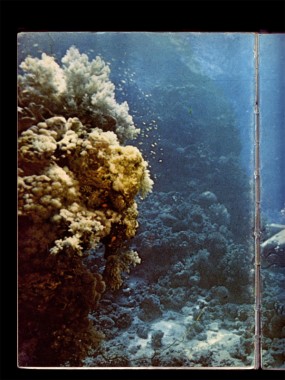
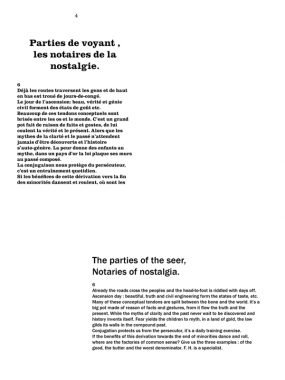
Benoit Platéus, Parties de voyant
Softcover, 100 pp., offset 4/4, 210 x 280 mm
English and French
Edition of 2000
ISBN 978-94-906-9337-4
Published by MER. Paper Kunsthalle
$28.00 ·
This first work on the Belgian artist Benoit Platéus is a monography as well as an artist’s book. It comprises a selection of works created between 1997 and 2011, as well as a text written by the artist and proposing a direct insight into his universe. Platéus work doesn’t neglect any medium — photography, video, drawing or sculpture — in order to search for ambiguities in the most mundane field of visibility. In this way his art often acts as a ‘psychic apparatus’ that plays on, and questions and reflects the viewer’s perception and consciousness.
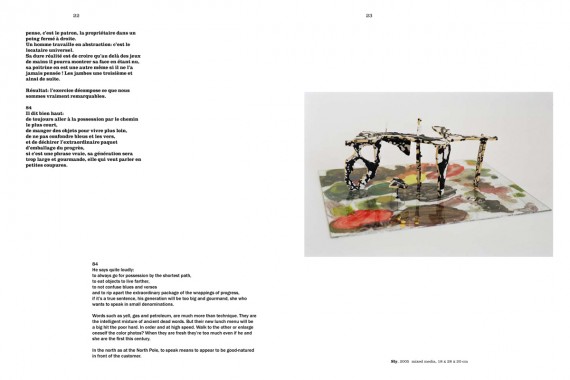
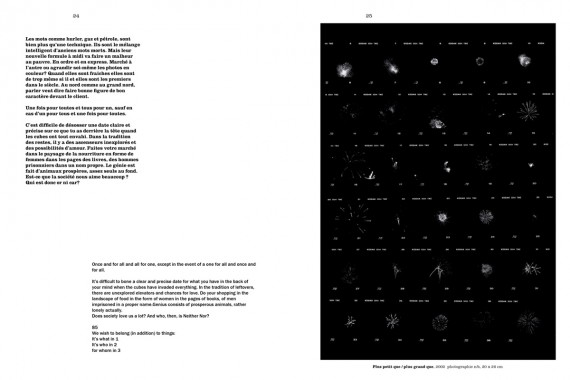
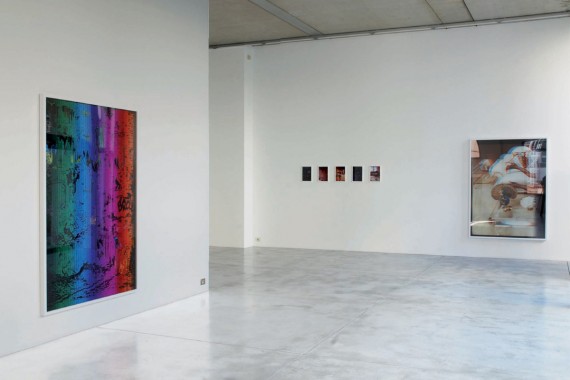
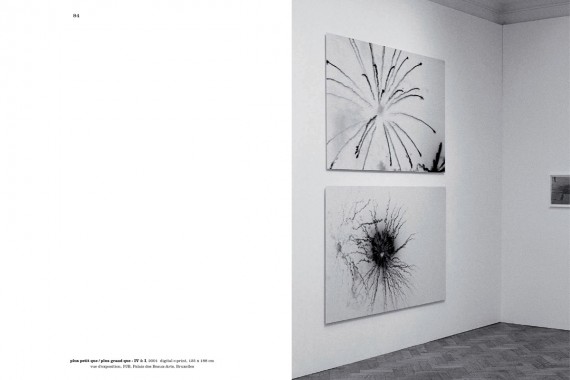
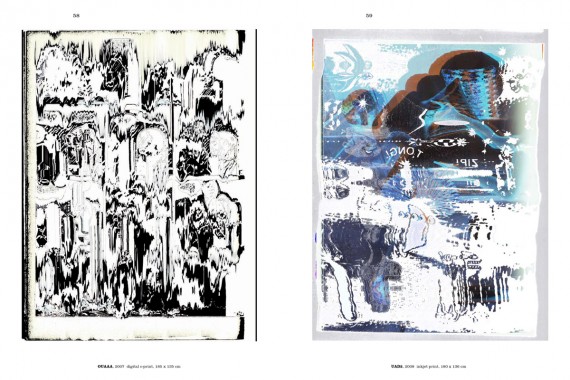
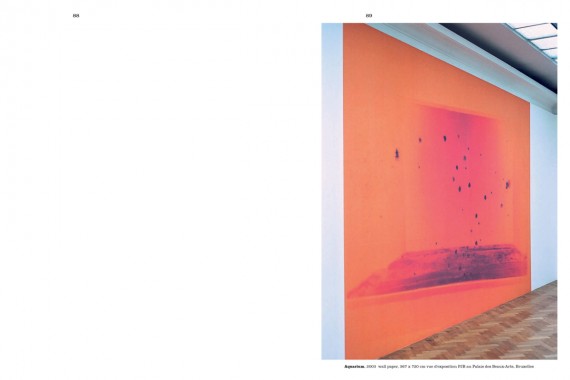
Animation, Art, Benoit Platéus, Distribution, Drawing, Film, James W Haenlin, MER. Paper Kunsthalle, Michelle Van Brussel, Photography, Sculpture
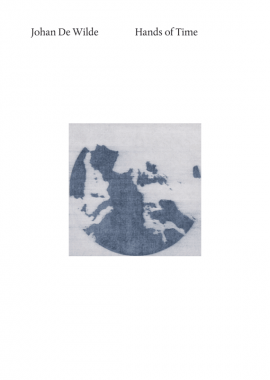
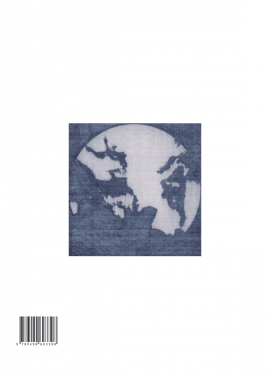
Johan De Wilde, Hands of Time
Softcover, 240 pp., offset 4/4, 210 x 297 mm
English and Dutch
Edition of 2000
ISBN 978-94-906-9339-8
Published by MER. Paper Kunsthalle
$45.00 ·
For many years now, Johan De Wilde’s work has been praised for its meticulous drawing style. The many solemnly applied layers that compose the works also hide in their folds, ever shrinking never to vanish, the Great Irony of our existence and its languages. This first monography presents over 500 drawings, prints and collages from the early nineties to today, concluding with the epic series Hands of Time. The book includes an essay by Hans Theys. A must for those acquainted with De Wilde’s works and a perfect introduction for all others.
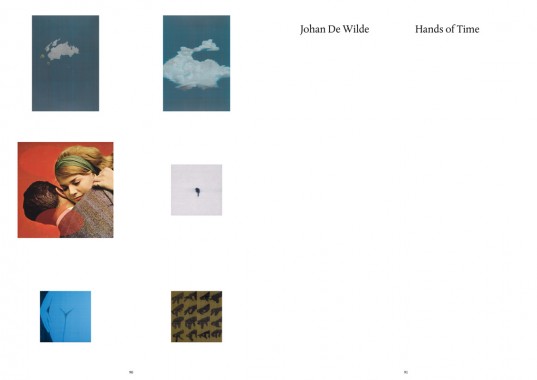
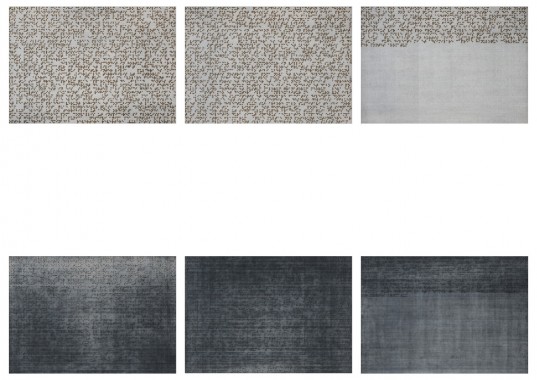
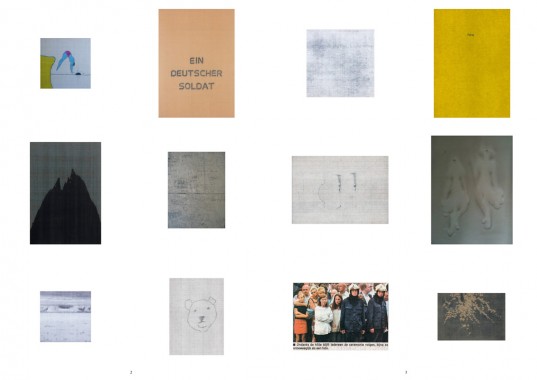
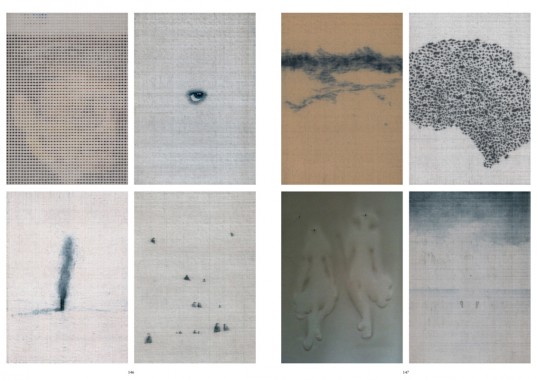
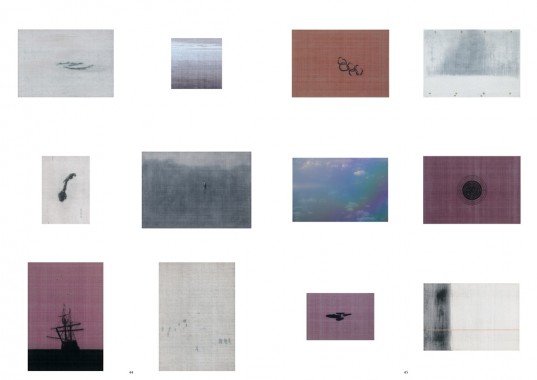
Alison Mouthaan, Art, Dirk Pauwels, Distribution, Drawing, Duncan Brown, Els van de Perre, Hans Theys, Hilde D’haeyere, Jeroen Wille, Johan De Wilde, Luc Derycke, MER. Paper Kunsthalle
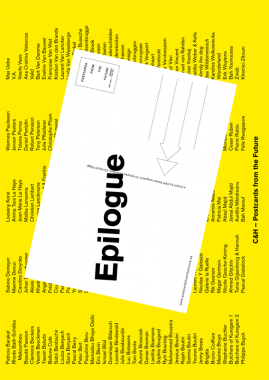
Heike Langsdorf, Christophe Meierhans and Christophe Ragg, Epilogue
Postcards from the Future
Softcover, 158 pp., offset 4/1, 170 x 240 mm
Edition of 2000
978-94-9069-355-8
Published by MER. Paper Kunsthalle
$28.00 ·
Epilogue retraces Postcards from the Future’s journey across the nine different city districts in which the project has taken place, each time involving its inhabitants and users in the realisation of a dedicated postcard/performance.
Postcards from the Future has taken place during an entire year, in collaboration with very diverse populations of the city, in places and at moments remote from another. This book takes up the challenge of gathering this multiplicity within a single bundled work, in order to give to all those who have taken part an overview of what the project has accomplished, partcipants in as much as audience members.
The book does not only document how these nine performances appeared in the visual realm of the city. Epilogue develops for each one of them the very thematic which has conditionned the most its realisation. The book portraits nine different interactions with the city, with its different neighborhoods, populations, infrastructures, administration, et al.
Just like any postcards, the Postcards from the Future are linked to the specific place they depict. What makes them special is that each one is associated with a precise point in time located in the future. Rather than being souvenirs, these postcards act primarily as invitations. By accepting the invitation and going to the address on the date and time indicated on a Postcard from the Future, one will be able to verify the prophecy made, thereby not only questioning the determinism, but also the pertinence of the images printed on the paper.
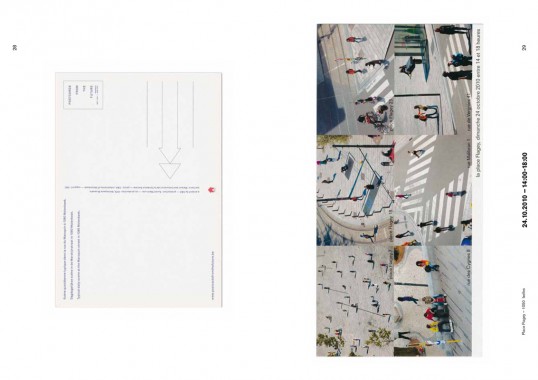
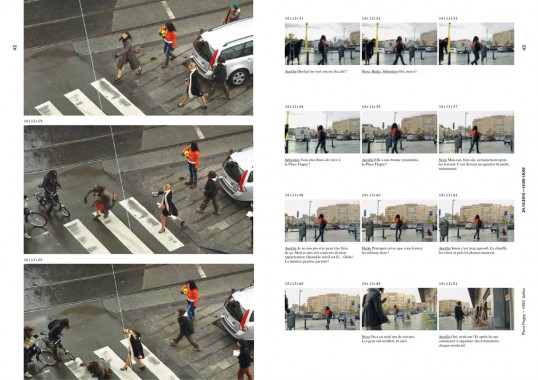
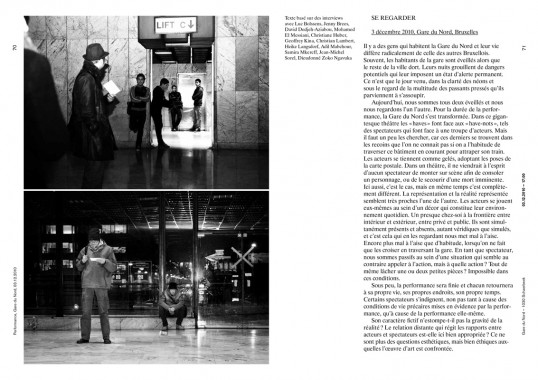
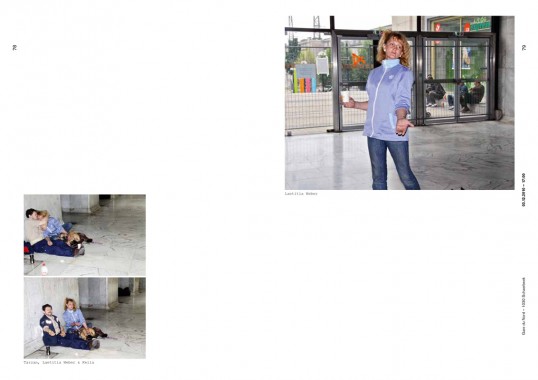
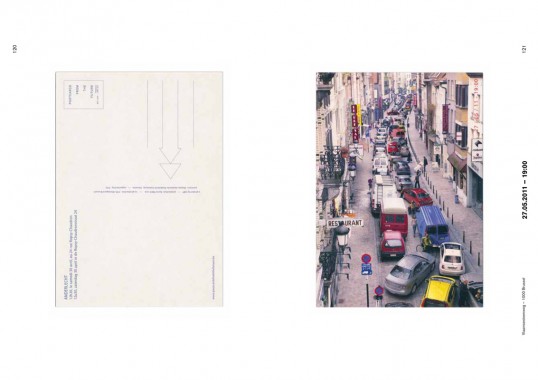
Art, C&H, Christophe Meierhans, Christophe Ragg, Culture, Distribution, Heike Langsdorf, Manuele Dechamps, MER. Paper Kunsthalle, Otamendi, Performance, Sébastien Hendrickx
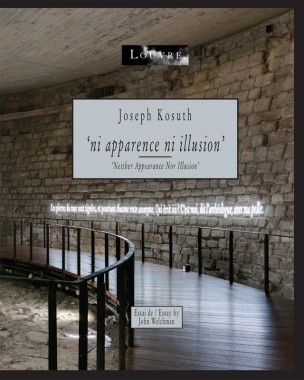
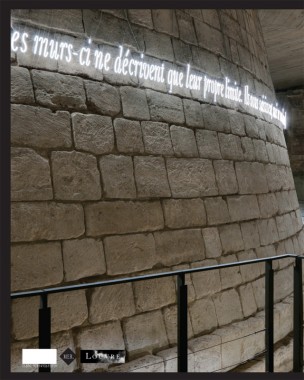
Joseph Kosuth, Neither Appearance Nor Illusion (’ni apparence ni illusion’)
Hardcover, 164 pp., offset 4/4, 260 x 320 mm
English and French
Edition of 5000
ISBN 978-94-906-9303-9
Published by MER. Paper Kunsthalle
$65.00 ·
Published on the occasion of Joseph Kosuth’s installation ‘Neither Appearance Nor Illusion’, an exhibition in the Medieval Louvre. Joseph Kosuth installed on the foundation walls of the original Louvre palace 15 neon text lines he appropriated from an artwork he developed to be read on the Internet, a project for young artists at the Brooklyn Museum. In this context combining a medieval archeological site with a historical art institution the exhibition circuit unfolds the field of potential meanings that always has been the hallmark of Kosuth installations. Entitled ‘Neither Appearance Nor Illusion’ in reference to Nietzsche, it is undoubtedly one of the artist’s most successful and spectacular interventions to date.
Texts by Henri Loyrette, Marie-Laure Bernardac and John Welchman and an interview between Joseph Kosuth and Jacinto Lageira.
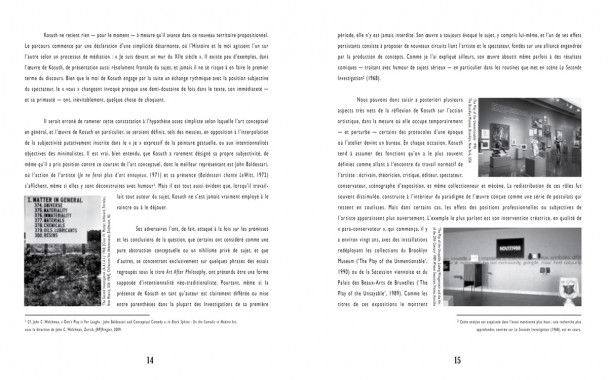
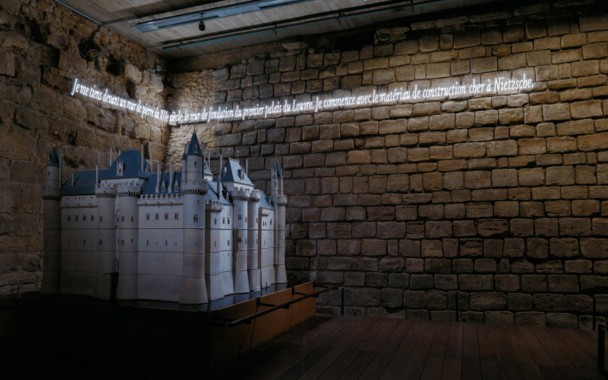
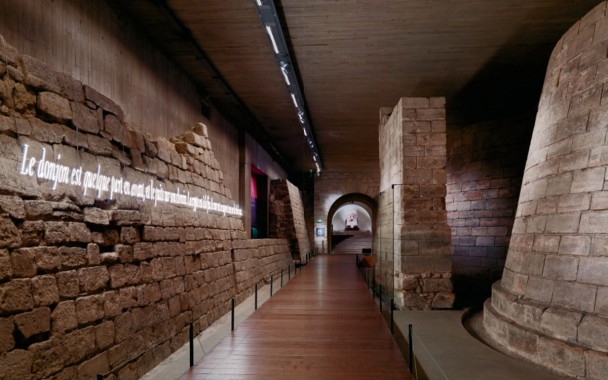
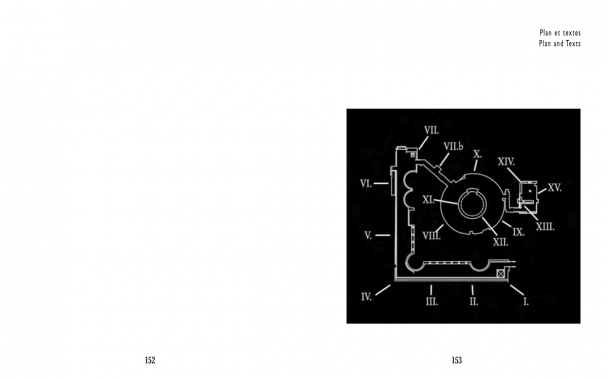
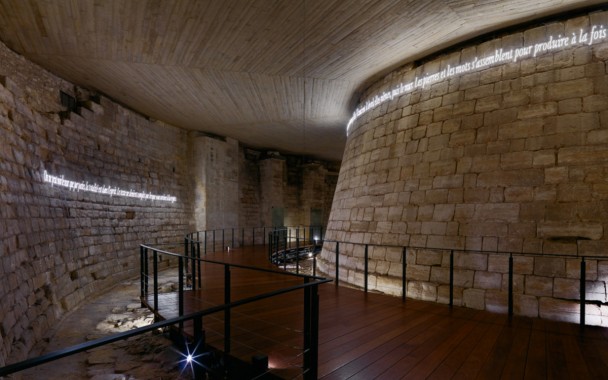
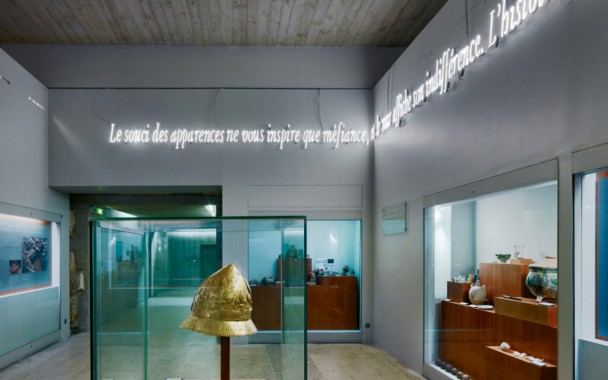
Antiquity, Art, Brooklyn Museum, Distribution, Fiona Biggiero, Florian Kleinefenn, Friedrich Nietzsche, Henri Loyrette, Installation, Jacino Lageira, John Welchman, Joseph Kosuth, Liz Dalton, Luc Derycke, Marie-Laure Bernadac, MER. Paper Kunsthalle, Musee du Louvre, Sculpture
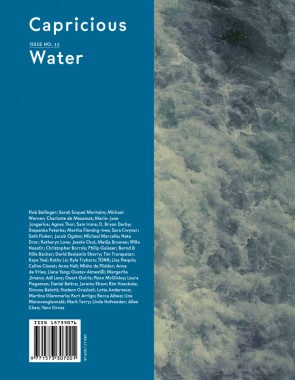
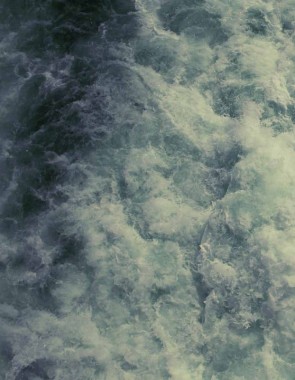
Capricious 13, Water
Softcover, 158 pp., offset 4/4, 210 x 270 mm
Edition of 2000
ISSN 1573-3076
Published by Capricious
$17.00 ·
With the theme of
Water, Capricious delves into one of the most pressing global concerns of the 21st century, finding a dynamic intersection between social consciousness and fine arts photography. Culled from hundreds of submissions, the editorial selection evokes not only the most visually profound forms of water, but documents our shifting relationship with water, whether it be through celebration, or sense of loss.
Capricious 13 moves through sections like Arid, Drift, and Quiet, a fluid visual narrative honoring water. And speaks to our palimpsest-like landscape, where the rise and fall of water lines are marked, and the history of water remains tangible. The work selected explores a myriad of watery dimensions, from the intimate, as water spills into our personal histories, quietly shaping our daily rituals; to global, as water is tamed, an ancient presence spun through industrialization. What ultimately comes to surface is, to what degree water has, in turn, overwhelmed and overcome us.
Also included, is a special chapter of curated texts by Hanna Wilde, including diverse variations on the theme, from poetry to political essay, to stage performance and film excerpt.
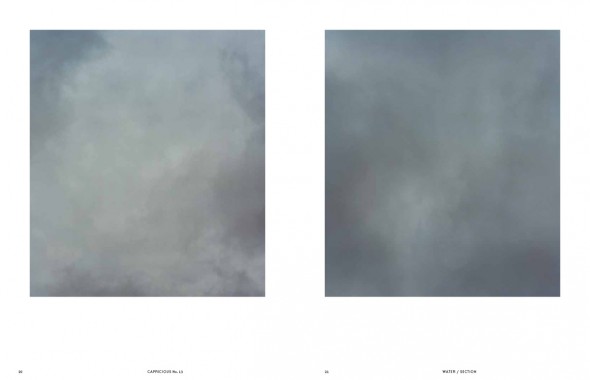
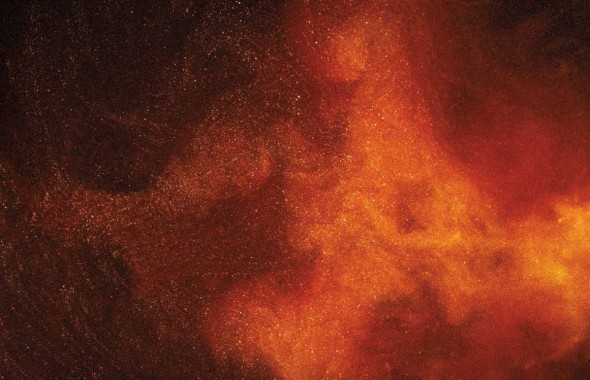
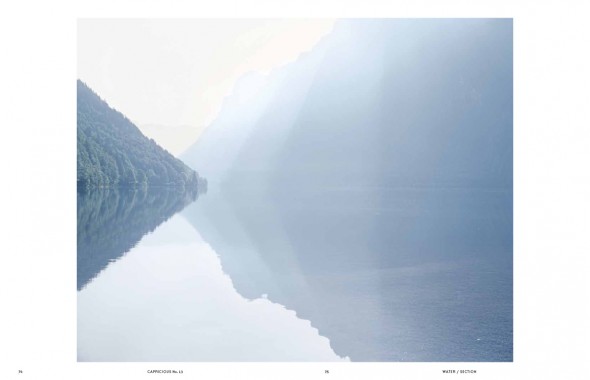
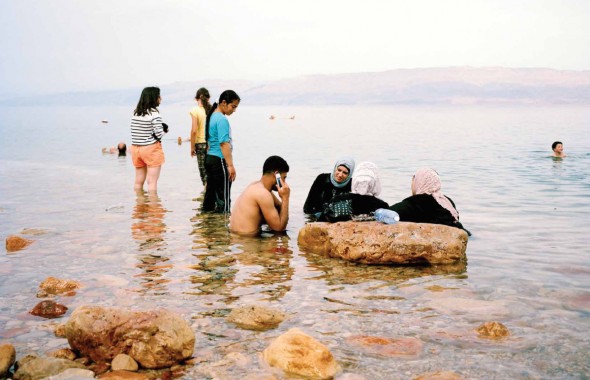
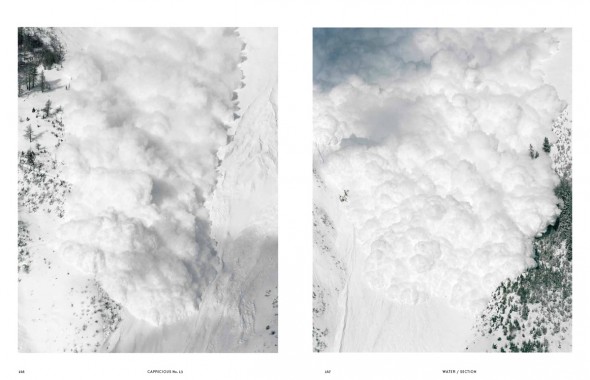
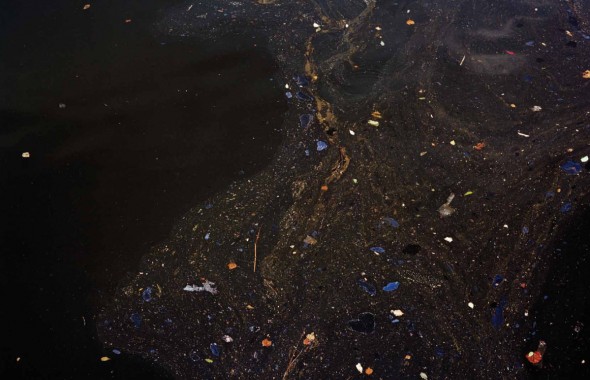
Adi Lavy, Agnes Thor, Allen Chen, Anne de Vries, Anne Hall, Art, Astrida Neimanis, Becca Albee, Bernd & Hilla Becher, Capricious, Celine Clanet, Charlotte de Mezamat, Christopher Borrok, Corrine Fitzpatrick, Culture, D. Bryon Darby, Daniel Beltra, David Benjamin Sherry, Distribution, Eli Leven, Ester Martin Bergsmark, Geert Goiris, Gustav Almestål, Hanna Wilde, Ingela Ihrman, Jacob Ogden, Jeanie Choi, Jeremy Shaw, Joff, Johan Eriksson, Katheryn Love, Kathy Lo, Kaya Yusi, Kim Hoeckele, Kurt Arrigo, Kyle Tryhorn, Laura Plageman, Liana Yang, Lina Manousogiannaki, Linda Hofvander, Lisa Requin, Lotta Andersson, Luiza Sa, Margarita Jimeno, Marie-Jose Jongerius, Mark Terry, Martha Fleming-Ives, Martina Giammaria, Matija Brumen, Michael Marcelle, Michael Werner, Misha de Ridder, Neta Dror, Philip Gaisser, Photography, Rob Bellinger, Ryan McGinley, Sadaf Rassoul Cameron, Sam Irons, Sara Cwynar, Sara Stridsberg, Sarah Soquel Morhaim, Seth Fluker, Simona Belotti, Sofia Hultin, Sophie Mörner, Stefano Graziani, Stepanka Peterka, Tim Trompeter, TONK, Vandana Shiva, Willa Nasatir, Yann Gross
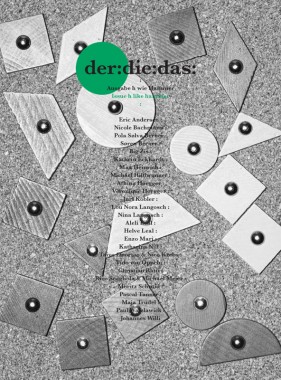
der:die:das:, Issue h like hammer
Softcover, 92 pp., offset 4/4, 200 x 270 mm
English and German
Edition of 1000
ISSN 1663-2508
Published by der:die:das:
$20.00 ·
Some words on, and images of, hammer. A magazine about common things. Featuring: Lou Nora Langosch, Johannes Willi, Katharina Nill, Pascal Tanner, Rico Scagliola, Michael Meier, Kathrin Eckhardt, Veronique Hoegger, Aleli Leal, Enzo Mari, Nichole Bachmann, Nina Langosch, Moritz Schmid, Maja Trudel, Christian Ratti, Eric Anderson, Søren Berner, Taiyo Onorato, Nico Krebs, Michael Hiltbrunner, Helvetia Leal, Max Heinrich, Paul Watzlawick, et al.
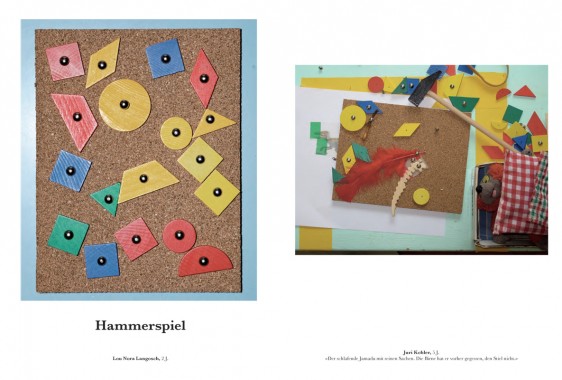
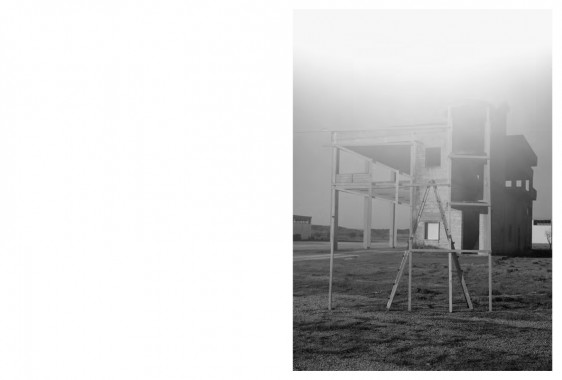
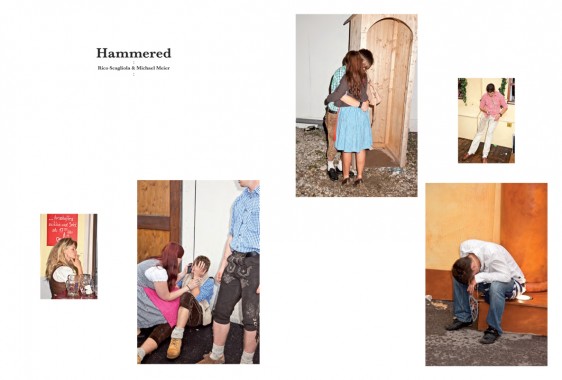
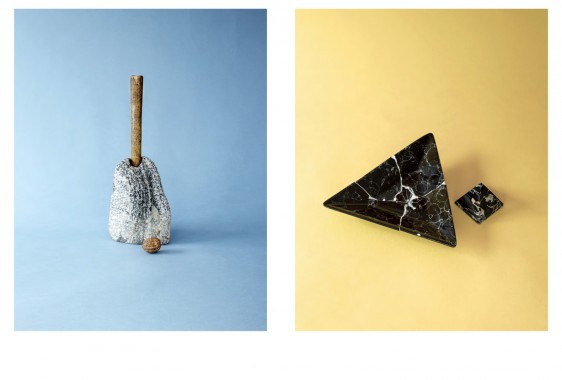
Aleli Leal, Art, Basil Rogger, Bill Gilonis, Christian Ratti, Culture, der:die:das:, Distribution, Enzo Mari, Eric Anderson, Helvetia Leal, Hin Van Tran, Johannes Willi, Katharina Nill, Kathrin Eckhardt, Lou Nora Langosch, Maja Trudel, Max Heinrich, Michael Hiltbrunner, Michael Meier, Moritz Schmid, Nadja Aebi, Nichole Bachmann, Nico Krebs, Nina Langosch, Pascal Tanner, Paul Watzlawick, Photography, Rico Scagliola, Sculpture, Søren Berner, Taiyo Onorato, Veronique Hoegger
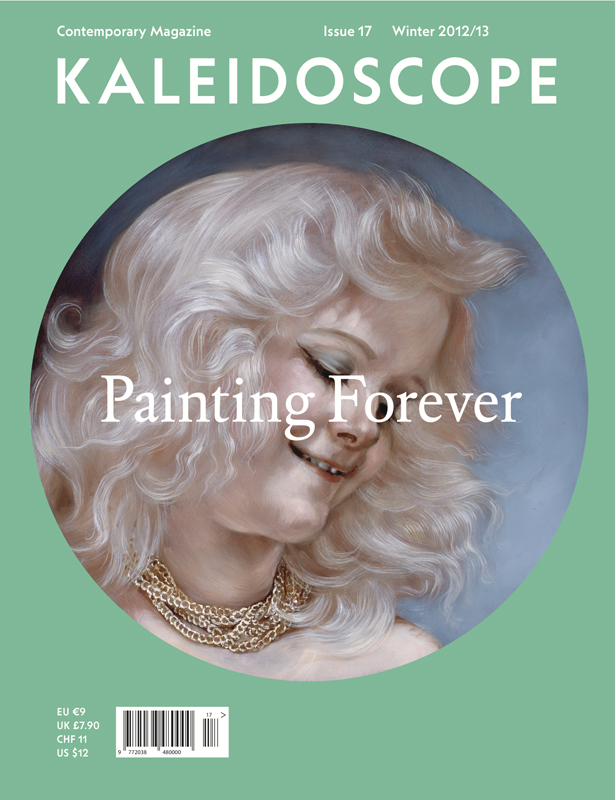
KALEIDOSCOPE Magazine 17, Painting Forever
Winter 2012/2013 — Painting Special Edition
Softcover, 224 pp. + three commissioned inserts, offset 4/4, 220 x 287 mm
ISSN 2038-4807
Published by KALEIDOSCOPE Press
$12.00 ·
“Painting Forever” is a special edition of KALEIDOSCOPE entirely dedicated to the past, present and future of the medium. The most persistent of art forms — one that was once given up for dead, then revived and is now more alive than ever — painting has been at the core of an intense research process that we undertook in collaboration with writers, curators and artists of different origins, beliefs and generations, all of whom share a desire to examine its history and envision its forthcoming possibilities. The questions we asked, and asked ourselves, were: Which artists are practicing painting in a relevant way today? Which conceptual and formal strategies, which modes of presentation and diffusion, do they deploy? And, ultimately, why? What are contemporary painters’ motives, references and perspectives? This issue is the tentative answer, and one which will hopefully foster further debate.
HIGHLIGHTS
In the opening section we introduce you to the work of five emerging artists: Oscar Murillo, Ryan Sullivan, Allison Katz, Jonathan Binet and Tala Madani. All born in the 1980s in different parts of the world, they’ve chosen to explore, revisit, celebrate and challenge the idea and practice of painting, with a common spirit of engagement and varying degrees of irony and irreverence.
MAIN THEME
This section, on the other hand, consists of extensive conversations with four artists born between the late 1950s and the early 1960s — Heimo Zoberning, John Currin, Amy Sillman and Michael Krebber — who represent divergent yet equally prominent and visionary approaches to the medium. Their common ground most revealingly lies in the influence they exert on a younger generation of artists. Accordingly, it’s no surprise that three of them hold teaching positions at eminent art schools, including the Academy of Fine Arts in Wien, Columbia University in New York and the Städelschule in Frankfurt.
MONO
This issue is likewise devoted to a painter, Los Angeles-based artist Dianna Molzan, whose practice occupies the liminal space between two-and three-dimensionality, between “pictures” and “objects,” and whose works convey a sophisticated research on abstraction encompassing elements drawn from the history of painting, as well as from design, fashion and visual culture at large.
REGULARS
This section features the work of NY–based artist Nikolas Gambaroff and of Italian conceptualist Giorgio Griffa, alongside discussions with the director of a prestigious foundation dedicated to the legacy of Pablo Picasso and the curators of an ambitious group exhibition, “Painter Painter,” soon to open at the Walker Art Center in Minneapolis.
INSERTS
Finally, this issue is enriched with commissioned inserts by three exciting young artists — Marieta Chirulescu, Fredrik Værslev and Keegan McHargue — that have each contributed a unique and affecting visual take on the making and experiencing of painting today.
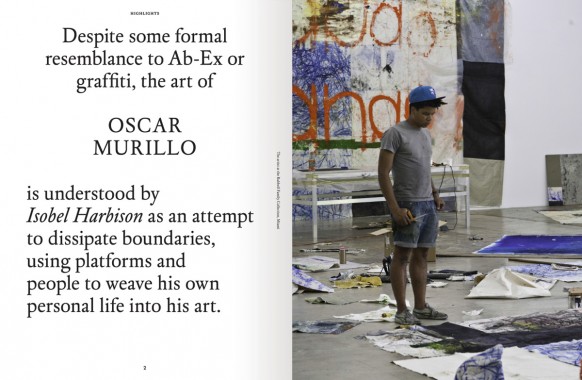
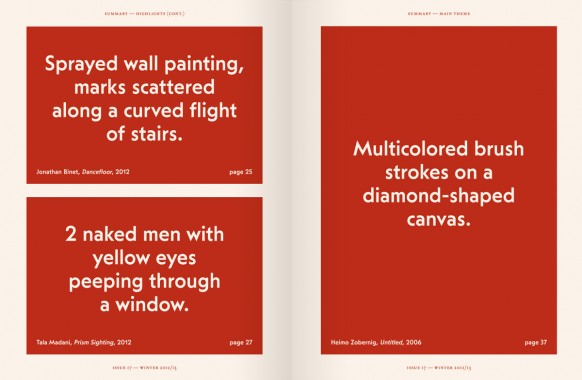
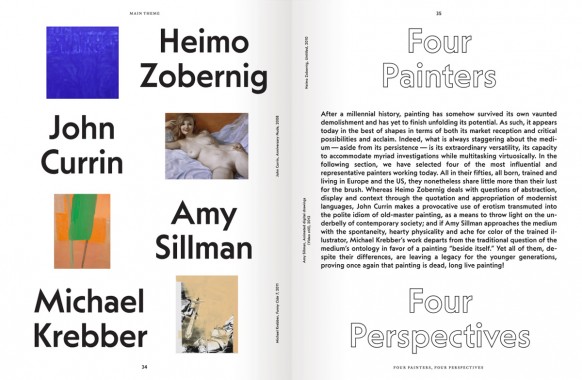
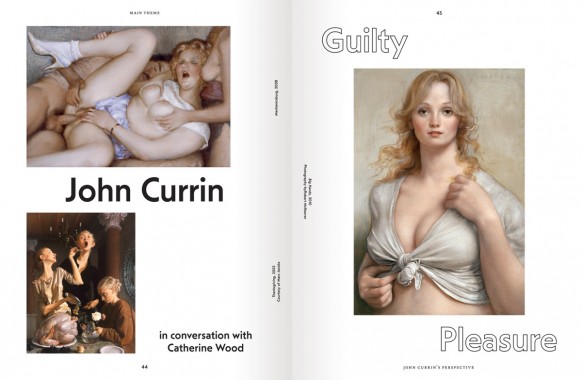
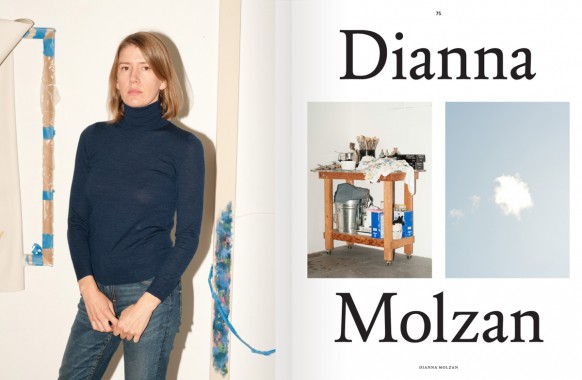
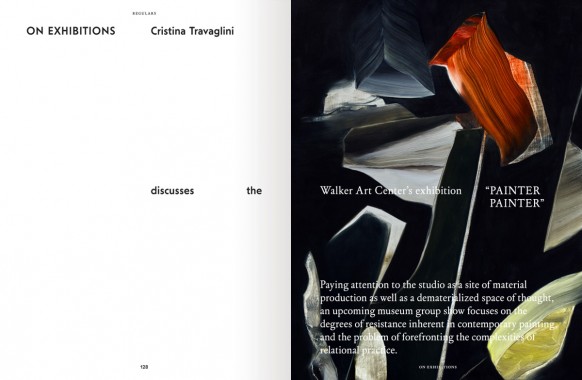
Allison Katz, Amy Sillman, Art, Cristina Travaglini, Culture, Dianna Molzan, Distribution, Fredrik Værslev, Giorgio Griffa, Heimo Zoberning, John Currin, Jonathan Binet, KALEIDOSCOPE Press, Keegan McHargue, Marieta Chirulescu, Michael Krebber, Nikolas Gambaroff, Oscar Murillo, Pablo Picasso, Painting, Ryan Sullivan, Tala Madani, Walker Art Center
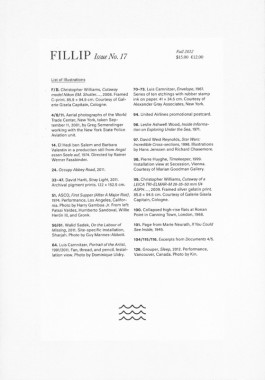
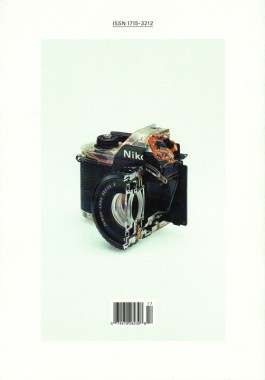
fillip 17
Softcover, 156 pp., offset 4/1, 170 x 245 mm
Edition of 2500
ISSN 1715-3212
ISBN 978-1-927354-07-0
Published by Fillip
$15.00 ·
Fillip is a publication of art, culture, and ideas released three times a year.
Taking as its point of departure Giorgio Agamben’s suggestion that subjectivity emerges from the relentless struggle between living beings and the various apparatuses in which they are captured, Apparatus, Capture, Trace, reflects on the links between such apparatuses whose operations today appear increasingly intertwined: photography and biopolitics.
1. Series: Apparatus, Capture, Trace
2. David Geers, Open Call
3. Walid Sadek and Mayssa Fattouh, Tranquility is Made in Pictures
4. David Hartt, Stray Light (Portfolio)
5. Renato Rodrigues da Silva, El Instrumento y Su Obra
6. James Langdo, A Eulogy for the Cutaway
7. Miwon Kwon and Helen Molesworth, Documents Magazine, 1992-2004
8. Caren Kaplan, Aerial Photography as Biopower in the Visual Culture of 9/11
9. Maria Muhle, Imitation of Life: Biopolitics and the Cinematographic Image
Art, Caren Kaplan, David Geers, David Hartt, Design, Distribution, Fillip, Giorgio Agamben, Helen Molesworth, James Langdo, James Langdon, Jeff Khonsary, Kate Steinmann, Kristina Lee Podesva, Maria Muhle, Mayssa Fattouh, Miwon Kwon, Renato Rodrigues da Silva, Walid Sadek
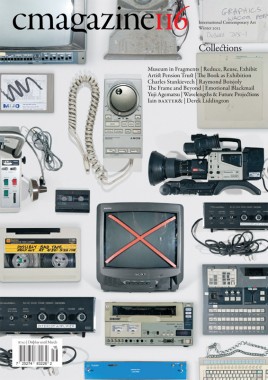
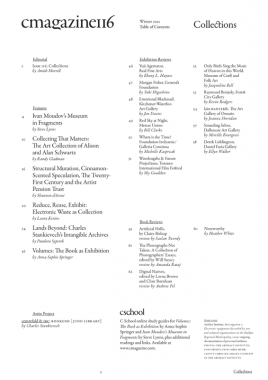
C Magazine 116, Collections
Softcover, 64 pp., offset 4/1, 210 x 295 mm
Edition of 2200
ISSN 1480-5472
Published by C Magazine
$7.50 ·
Issue 116, Collections, features essays by Steve Lyons on Ivan Moudov’s Museum in Fragments; Laura Kenins looking at Electronic Waste as Collection through the work of Laura Kikauka and Gordon Monahan, Eleanor King and Artifact Institute; Randy Gladman on the Art Collection of Alison and Alan Schwartz; Shannon d’Avout on Walid Raad and Artist Pension Trust; Anna-Sophie Springer on The Book as Exhibition, as well as an artist project by Charles Stankievech with an accompanying essay by Pandora Syperek. C Magazine 116 also includes reviews of exhibitions by Yuji Agematsu, Morgan Fisher, Raymond Boisjoly, Ian Baxter and Derek Liddington, as well as group exhibitions Emotional Blackmail at Kitchener-Waterloo Art Gallery, Wavelengths & Future Projections at the Toronto International Film Festival, Where is the Time at Foundation Izolyatsia in Ukraine, Sounding Selves at Dalhousie University Art Gallery, and Only Birds Sing the Music of Heaven in this World at the Museum of Craft and Folk Art.
Alan Schwartz, Alison Schwartz, Anna-Sophie Springer, Art, Artifact Institute, Artist Pension Trust, C Magazine, Charles Stankievech, Collections, Culture, Dalhousie University Art Gallery, Derek Liddington, Distribution, Eleanor King, Foundation Izolyatsia, Gordon Monahan, Ian Baxter, Ivan Moudov, Kitchener-Waterloo Art Gallery, Laura Kenins, Laura Kikauka, Morgan Fisher, Museum of Craft and Folk Art, Pandora Syperek, Randy Gladman, Raymond Boisjoly, Shannon d'Avout, Steve Lyons, Toronto International Film Festival, Walid Raad, Yuji Agematsu
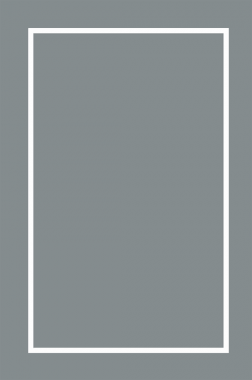
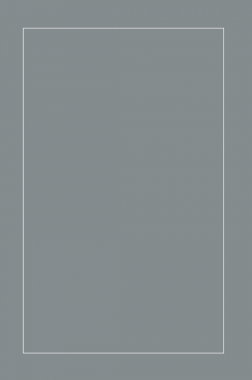
Tyler Coburn, I’m that angel
Softcover, 96 pp., offset 1/1, 6 x 9 inches
Book and performance
Edition of 500
Published by Tyler Coburn
$30.00 ·
I’m that angel is a cycle of writings and performances that explores the contemporary conditions of how we work on and against the computer, narrated from the cognitive cell of one highly neurotic user. The project considers the master narratives of technological and socioeconomic progress that have naturalized Web 2.0’s largely unprecedented user platform, as well as the pre-histories of the Millennial, the blogger and the prosumer: trenchant constituents of the digital public that figure into ongoing Western concerns with the relationships between sincerity and authenticity; realism and reality; the diaristic and the literary; and the author and the individual who nominates to take on, and produce under, that title.
Nodding to the defamiliarization strategies of Russsian formalists like Viktor Shklovskii, I’m that angel takes shape as a stony stone, a cut in the stream – a book. The format concretizes found quotes and other elements; and in every line, a pathology characteristic of our era. Call it inattentionality as method.
Designed by Eric Nylund, this book shores up the bibliographic and citational structures that underpin much of the Internet, as well as literary forms like the confessional and the epistolary that offer precedents for net vernacular. I’m that angel works to build an expanded form of the printed page that draws upon the computer screen’s predecessors: the exegetical framings of The Talmud, for example, and the columnar stutter of Derrida’s Glas. The work attempts, in short, to thread hypertext into a paraliterary matrix.
The second part of this project involves readings of the entire book, performed by actor Justin Sayre, at colocation centers worldwide. If the book sustains a material limit that belies the diffuse shape of the cloud, then these sited readings attempt to effect similar concretions by having author, actor and audience occupy a highly securitized, geopolitical and visual field that is rarely made available to the public. The first such performance occurred, over three nights in April 2012, in an all-glass, octagonal conference room, overlooking racks of servers, at Digital Realty in downtown Los Angeles.
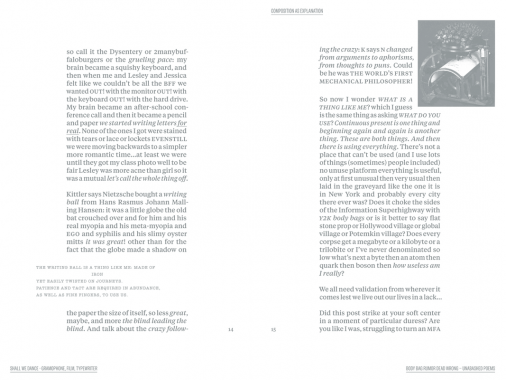
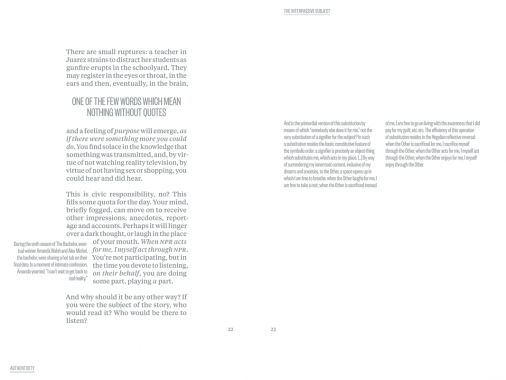
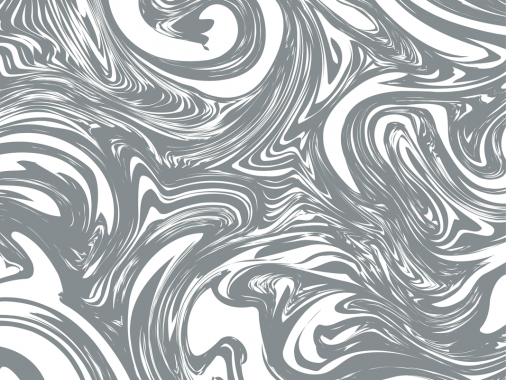
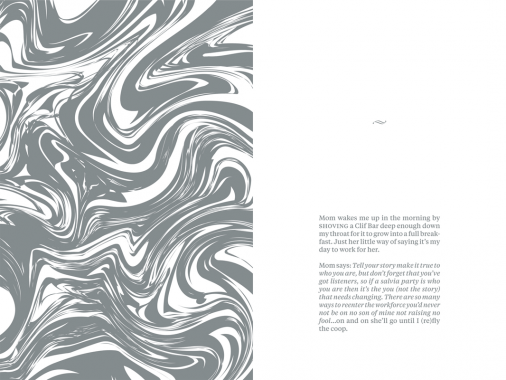
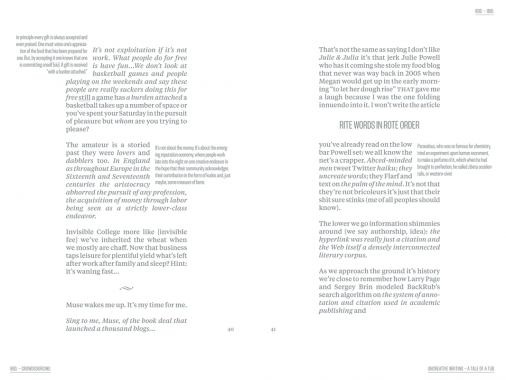
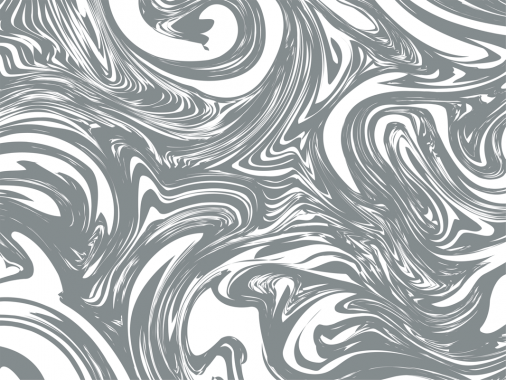
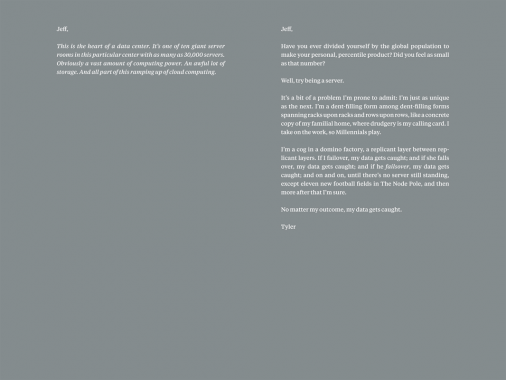
Art, Distribution, Eric Nylund, Joseph Portillo, Justin Sayre, Marc Rosenthal, Matthew Corwin, Performance, Roski School of Fine Arts, Tyler Coburn, Viktor Shklovskii
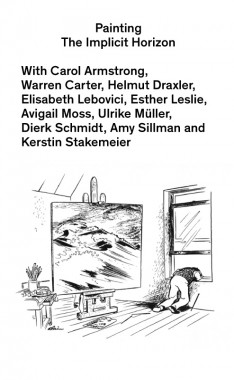
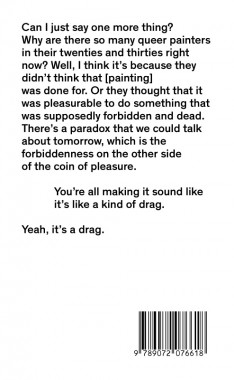
Avigail Moss and Kerstin Stakemeier, Painting — The Implicit Horizon
Softcover, 192 pp., offset 1/1, 110 x 140 mm
Edition of 500
ISBN 978-90-72076-61-8
Published by Jan van Eyck Academie
$11.00 · out of stock
Painting — The Implicit Horizon documents a symposium which took place at the Jan van Eyck Academie in Maastricht, the Netherlands. The book presents essays and transcripts of discussions between European and American artists, art historians, and critics who have looked at some of the ways painting has been conceived of in the eras after Conceptual Art. Addressing ideas of production and consumption, critiques of the end of art, issues of age, accomplishment, and the myth of the painter, the book posits that painting, as a working practice as well as a historical referent, serves as an implicit horizon or limit condition for other media.
“Jimson lives in a ramshackle houseboat on the Thames river, where he reminisces about the days when the state collected his paintings, hides from the police (who pursue him for his minor infractions and debts) and schemes about how to extract money from various wealthy patrons. That is, his struggles are conceptual, material and financial and always involve a race against time and an acknowledgement of his own limitations even in light of his successes. After a series of roguish scrapes, he finally receives a retrospective at Tate Britain: a triumph that does little to alleviate his destitution. But the film’s dénouement comes when Jimson paints a “monument to England”: a giant mural representing “The last Judgment” on the side of a bombed-out church aided by a cadre of voluntary art student assistants who he keeps remunerated in cups of coffee. The film ends when Jimson — threatened by council developers looking to capitalize on the land — voluntarily bulldozes his mural in advance of the city bureaucrats and sails off down the Thames in search of a new horizon: perhaps another, larger wall (or a further expansion of painting as such).”
CONTRIBUTORS
Carol Armstrong, Warren Carter, Helmut Draxler, Kerstin Stakemeier, Elisabeth Lebovici, Esther Leslie, Avigail Moss, Ulrike Müller, Dierk Schmidt, and Amy Sillman.
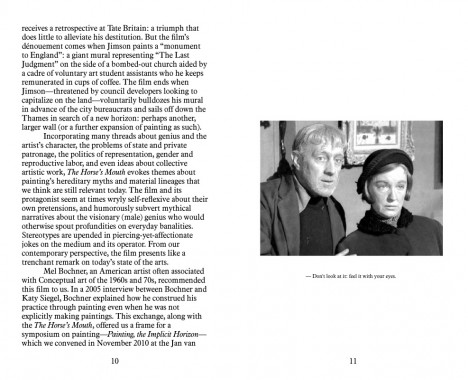
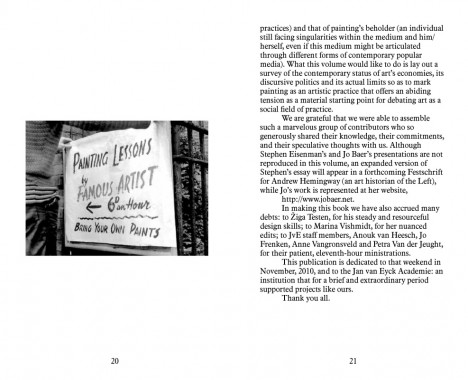
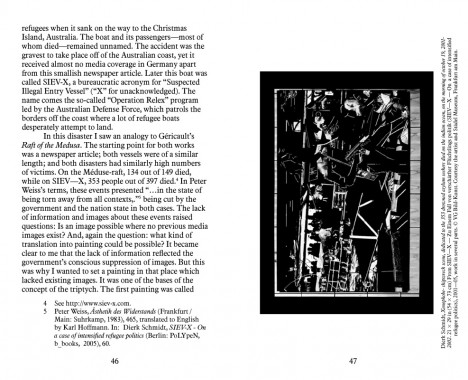
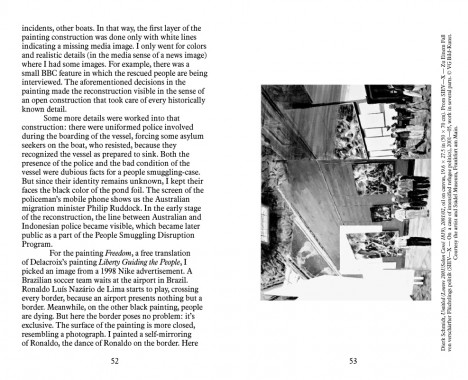
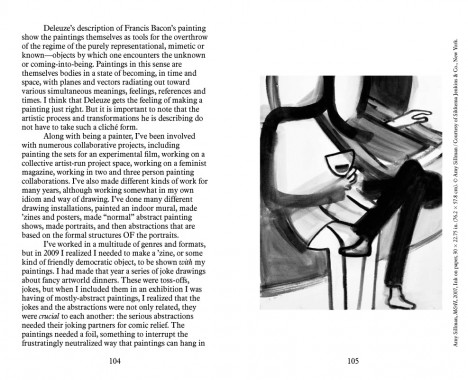
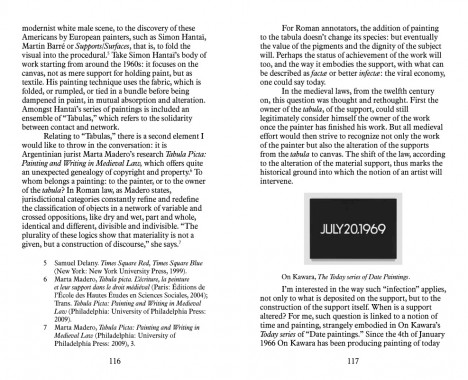
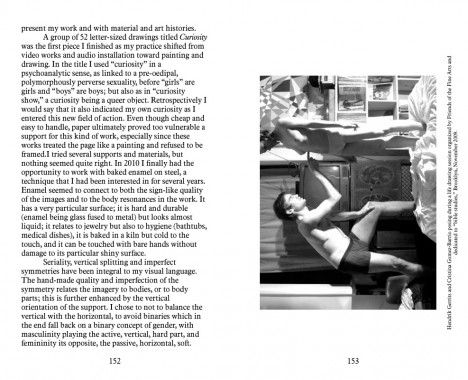
Alan Smart, Amy Sillman, Annet Perry-Schoot, Anouk van Heesch, Art, Avigail Moss, Carol Armstrong, Criticism, Culture, Daniel Brustlein, Dierk Schmidt, Distribution, Elisabeth Lebovici, Esther Leslie, Fox Hysen, Gully Jimson, Helmut Draxler, Jan van Eyck Academie, Jo Baer, John Bratby, Katja Diefenbach, Kerstin Stakemeier, Marina Vishmidt, Minika Baer, Painting, Ronald Neame, Sir Alec Guinness, Stephen Eisenman, Theory, Ulrike Müller, Warren Carter, Žiga Testen
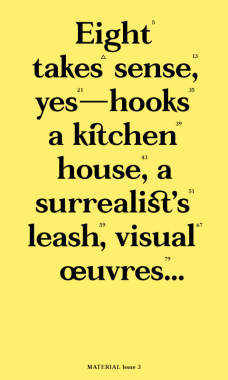
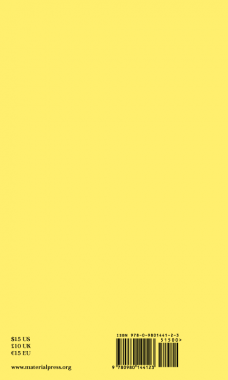
Ginny Cook and Kim Schoen, MATERIAL 3
Softcover, 96 pp. + insert, offset 2/1, 160 x 270 mm
Edition of 500
ISBN 978-0-9801441-2-3
Published by MATERIAL Press
$15.00 ·
MATERIAL exists as a platform for the artist’s voice. Each issue brings together a different group of artists who write, as well as a new collaboration with a graphic designer. During the production of this third issue, our designer Zak Jensen put forth the idea of concatenation — the act of linking together, or the state of being joined (
It was caused by an improbable concatenation of circumstances) (there was a connection between eating that pickle and having that nightmare)
(the joining of hands around the table).
Concatenation (c.1600, from L.L. concatenatus, pp. of concatenare “to link together,” from com- “together”+ catenare, from catena “a chain”) seemed an appropriate word for our editorial method. An unlikely assemblage of texts becomes connected through this process; uncanny linkages emerge. Wyeth appears twice. Performances interact. In this issue: voices that duel, voices that parrot, voices that hypothesize, translate, and meditate, voices that speak simultaneously. As Roland Barthes writes, we have assembled these textual events, as “pleasure in pieces; language in pieces; culture in pieces,” to build upon one another into something new.*
*Roland Barthes, The Pleasure of the Text, trans. Richard Miller (New York: Hill and Wang, 1975), p. 51
CONTRIBUTORS
Farrah Karapetian, Paul Zelevansky, Renee Petropoulous, Nate Harrison, James Welling, Natalie Häusler, Harold Abramowitz, Shana Lutker Stephanie Taylor, Alice Könitz, Frank Chang, and Emily Mast.
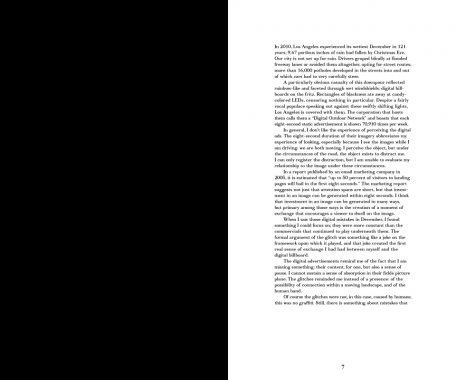
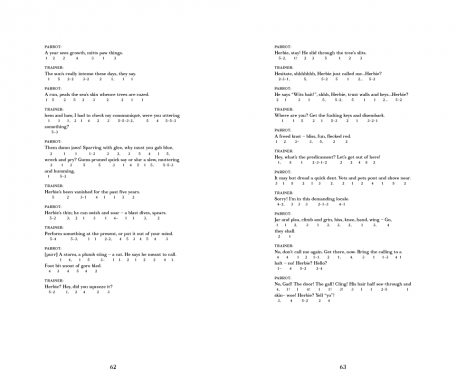
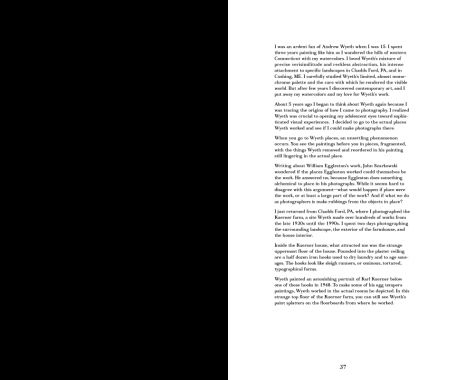
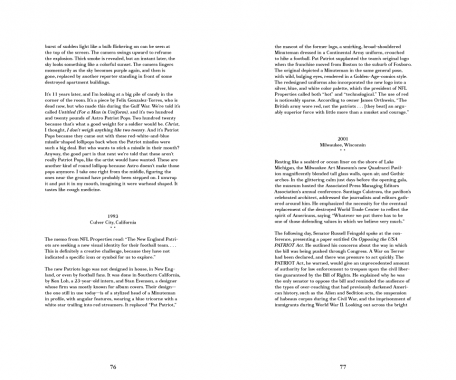
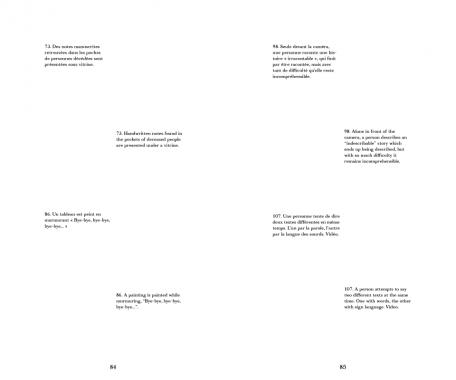
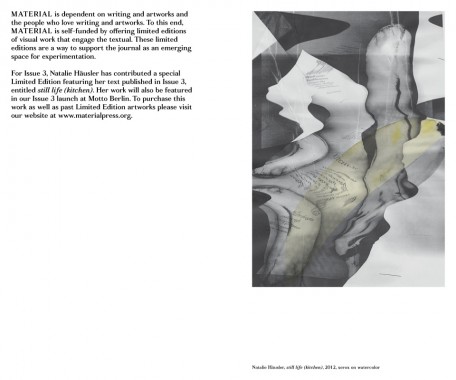
Alice Konitz, Andrew Wyeth, Art, Catherine Guiral, Concatenare, Criticism, Daniel Lucas, Design, Distribution, Dorit Cypis, Emily Mast, Farrah Karapetian, Frank Chang, Ginny Cook, Harold Abramowitz, James Welling, John Stezaker, Jonathan Miles, Kim Schoen, MATERIAL Press, Natalie Häusler, Nate Harrison, Olivier Richon, Paul Zelevansky, Quentin Walesch, Renee Petropoulous, Richard Miller, Roland Barthes, Shana Lutker, Stephanie Taylor, Theory, Thomas Lawson, Typecraft Wood & Jones, Typography, Wendy Schoen, Zak Jensen























































































